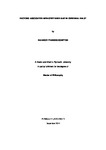Factors associated with stiff knee gait in cerebral palsy
| dc.contributor.supervisor | Marsden, Professor Jonathan | |
| dc.contributor.author | Compton, Eleanor Frances | |
| dc.contributor.other | Faculty of Health | en_US |
| dc.date.accessioned | 2015-06-11T13:34:16Z | |
| dc.date.available | 2015-06-11T13:34:16Z | |
| dc.date.issued | 2015 | |
| dc.identifier | 10404785 | en_US |
| dc.identifier.uri | http://hdl.handle.net/10026.1/3360 | |
| dc.description.abstract |
Stiff knee gait (SKG) is one of a few classified walking patterns which people with cerebral palsy (pwCP) can present with. The characteristic for SKG is delayed and/or reduced peak knee flexion during swing phase, which can reduce walking ability and result in functional restrictions. Through the use of both clinical and laboratory based measures this cross-sectional study aimed to identify the factors associated with SKG, suggest possible treatment options and propose potential directions for future research. The impact of five variables on knee flexion amplitude during the swing phase of gait was assessed. Data was gathered from a group of 27 pwCP and 20 age-matched controls. Three dimensional motion analysis was used to record the kinetics and kinematics of the pelvis and lower limbs. Isometric strength of the ankle plantarflexors, knee extensors, hip flexors and hip extensors was recorded via maximal voluntary contraction using a dynamometer. Passive and stretch-mediated stiffness of the knee extensors was also recorded using a dynamometer with two set stretch speeds. The main findings highlight that several factors are correlated with SKG. The key determinants of which are a crouch positioning of the lower limb in stance phase and spasticity within the knee extensors. Additionally, secondary analysis highlighted the importance of the knee extensors inner/outer range strength ratio. Greater weakness in inner range was linked to increased spasticity, to the degree of crouch and in turn to a smaller degree of knee flexion in swing phase. This study further highlighted that both clinical and laboratory based measures may be used to determine the possible causes of SKG but that laboratory based gait analysis and outcome measures were more sensitive and had higher predictive power. The implications for treatment are to be mindful of the fact that by attempting to improve one impairment it does not have a negative effect upon another. Inter-relationships between impairments need to be looked at in more detail. Future work should evaluate treatments on SKG of strengthening the inner range quadriceps with/without a stretching programme. | en_US |
| dc.language.iso | en | en_US |
| dc.publisher | Plymouth University | en_US |
| dc.subject | Cerebral palsy | |
| dc.subject | Stiff knee gait | en_US |
| dc.title | Factors associated with stiff knee gait in cerebral palsy | en_US |
| dc.type | Masters | en_US |
| plymouth.version | Full version | en_US |
Files in this item
This item appears in the following Collection(s)
-
01 Research Theses Main Collection
Research Theses Main


